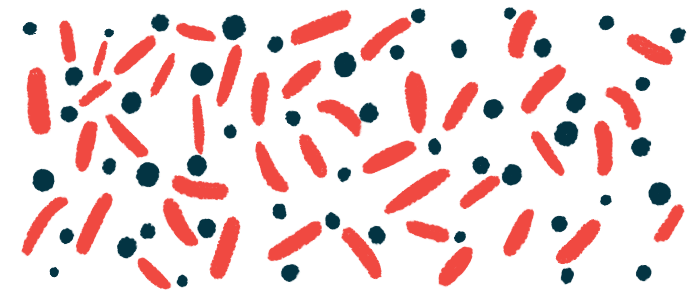Faster lung function decline in CF linked to anti-P. aeruginosa virus
Pf bacteriophage may serve as biomarker, potential therapeutic target: Study
Written by |

A more rapid decline in lung function in people with cystic fibrosis (CF) has been linked in a new study to high sputum levels of a virus that infects the bacteria Pseudomonas aeruginosa, which is a major contributor to lung disease in CF.
The virus, called Pseudomonas filamentous (Pf) bacteriophage, in the sputum was also associated with a pro-inflammatory and antiviral immune response, and the formation in CF airways of liquid crystalline biofilms, which are layers of microbes that confer immune and treatment resistance.
Lung function decline may be due to P. aeruginosa infection plus the Pf-induced formation of these biofilms in the airways and a shift from an antibacterial to an antiviral immune response, according to researchers.
“Pf may serve as a prognostic biomarker and potential therapeutic target for [P. aeruginosa] infections in CF,” researchers wrote in the study “Pf bacteriophage is associated with decline in lung function in a longitudinal cohort of patients with cystic fibrosis and Pseudomonas airway infection,” which was published in the Journal of Cystic Fibrosis.
P. aeruginosa infections often resistant to immune responses, antibiotics
Infections with P. aeruginosa are often resistant to immune responses and antibiotics because they form biofilms, or layers of microorganisms that stick together as a protective mechanism.
Despite the benefits of CFTR modulator therapies in improving lung function and quality of life, airway inflammation and persistent infections, particularly with P. aeruginosa, remain a challenge.
Bacteriophages, or just phages, are viruses that can infect and kill bacteria. On the one hand, phages represent a promising strategy for treating antibiotic-resistant lung infections in CF and have shown promise in clinical trials.
Still, some phages in the sputum of many CF patients, including the Pf bacteriophage, which infects and reproduces in P. aeruginosa, have been associated with poor outcomes when examined at a single time point. Also, in chronic infection animal models, Pf has been linked to a shift toward an antiviral immune response, which would aid in the persistence of chronic bacterial infections.
Building on these findings, a team led by researchers at the University of Southern California and Stanford University hypothesized that “Pf presence provides a selective advantage to [P. aeruginosa] in the CF airway, leading to increased bacterial fitness and worse outcomes over time.”
To test this hypothesis, the team followed 121 CF patients at the Stanford CF Center in California to investigate the relationship between Pf and clinical outcomes.
Based on a genetic analysis of sputum samples, 39 patients tested negative for P. aeruginosa, 39 were positive for P. aeruginosa but negative for Pf, and 43 had both P. aeruginosa and Pf.
‘Pf is associated with chronic stage of infection’
Patients with the bacteria and phage were significantly older than those with P. aeruginosa alone and contributed more sputum samples, suggesting “Pf is associated with chronic stage of infection and may be associated with higher sputum production,” the team wrote.
The mean length of follow-up, which ranged from 3.1 to 3.8 years, was similar across all three groups. At the start of the study, no difference was found between groups in lung function or CF-related diabetes. Also, the mortality or lung transplant rates were similar, as was the use of azithromycin antibiotics or CFTR modulators at enrollment or during the study.
When P. aeruginosa levels were measured, there was no significant difference in samples with and without Pf. Still, Pf levels were markedly higher than P. aeruginosa, “indicating active Pf production by [P. aeruginosa] in the airway,” the team noted. Of those who tested positive for Pf, more than half (62%) had the phage in all of their sputum samples, demonstrating that “Pf is prevalent and persistent in a subset of [CF patients],” the researchers added.
Lung function among CF patients without P. aeruginosa improved over time, while those with P. aeruginosa saw a slow but nonsignificant decline. In contrast, patients with P. aeruginosa and high Pf production showed a significant decrease in lung function (1.53% per year) compared with the other groups. This effect was independent of CFTR modulator use.
In Pf-positive sputum samples, the levels of several pro-inflammatory immune signaling proteins, called cytokines, including GM-CSF, interleukin-1b (IL-1b), IL-6, leptin, and MIP-1a, were significantly higher compared with healthy individuals. Significantly elevated levels of IL-10, an immunomodulatory cytokine associated with an antiviral immune response, were also found. At the same time, the presence of Pf was not linked to infection with other microbes.
The researchers then examined tissue sections of explanted lungs from CF patients who underwent lung transplant. When examined under a microscope, mucus plugs in the airways of the CF patients with the bacteria and phage showed signs of liquid crystals, which confer biofilms resistance to clearance. Moreover, the degree of crystal formation was significantly higher in samples of P. aeruginosa with high Pf than with low Pf.
“We have demonstrated Pf production in sputum to be associated with decline in lung function as well as an inflammatory and antiviral response in a longitudinal cohort study of [CF patients],” the researchers wrote. “Pf may be a useful prognostic biomarker which could be used to identify those at risk for precipitous decline and thus signal the need for early and aggressive intervention…. Additionally, Pf may have potential as a therapeutic target in disruption of biofilm and treatment of chronic [P. aeruginosa] infection.”








